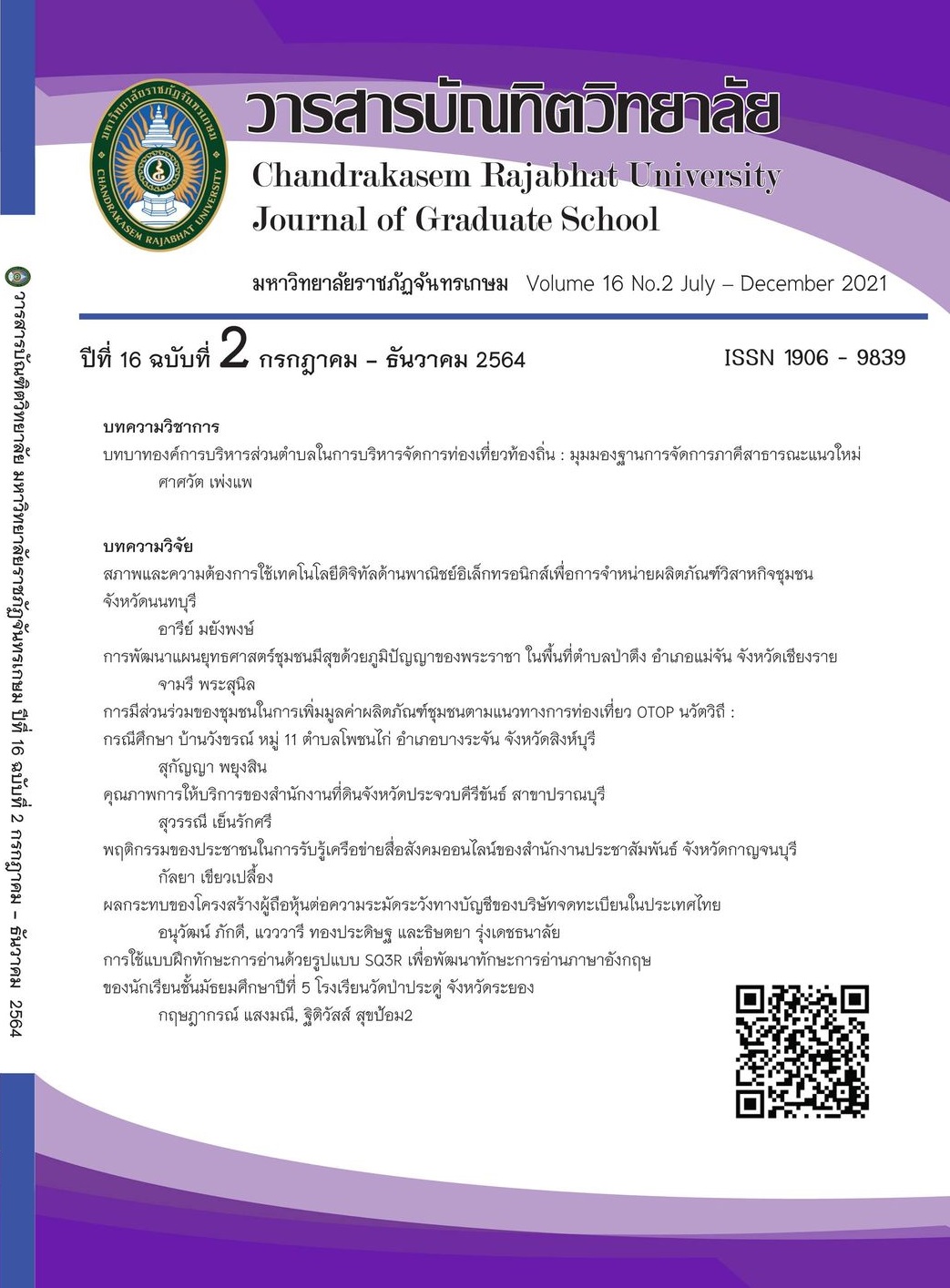พฤติกรรมของประชาชนในการรับรู้เครือข่ายสื่อสังคมออนไลน์ของสำนักงานประชาสัมพันธ์ จังหวัดกาญจนบุรี
Main Article Content
บทคัดย่อ
การวิจัยครั้งนี้มีวัตถุประสงค์เพื่อศึกษา (1) ระดับพฤติกรรมของประชาชนในการรับรู้เครือข่ายสื่อสังคมออนไลน์ของสำนักงานประชาสัมพันธ์ จังหวัดกาญจนบุรี (2) ปัจจัยในการรับรู้เครือข่ายสื่อสังคมออนไลน์ของสำนักงานประชาสัมพันธ์ จังหวัดกาญจนบุรี (3) ปัจจัยในการรับรู้เครือข่ายสื่อสังคมออนไลน์ที่มีความสัมพันธ์เชิงเหตุ - ผล กับพฤติกรรมของประชาชนในการรับรู้เครือข่ายสื่อสังคมออนไลน์ของสำนักงานประชาสัมพันธ์ จังหวัดกาญจนบุรี กลุ่มตัวอย่างที่ใช้ในการวิจัย ได้แก่ ประชาชนที่อาศัยอยู่จังหวัดกาญจนบุรี จำนวน 400 คน วิเคราะห์ข้อมูลโดยใช้ค่าสถิติเชิงพรรณนา ได้แก่ ค่าร้อยละ ค่าเฉลี่ย ค่าเบี่ยงเบนมาตรฐาน และสถิติเชิงอนุมาน โดยใช้สถิตการวิเคราะห์การถดถอยพหุคูณ
ผลการศึกษาพบว่า (1) พฤติกรรมของประชาชนในการรับรู้เครือข่ายสื่อสังคมออนไลน์ของสำนักงานประชาสัมพันธ์ จังหวัดกาญจนบุรี ในภาพรวมมีพฤติกรรมในการรับรู้อยู่ในระดับมากทุกด้าน เรียงตามลำดับ ดังนี้ การเปิดรับข่าวสาร การสื่อสารผ่านอินเทอร์เน็ต และการแสวงหาสารสนเทศ (2) ปัจจัยในการรับรู้เครือข่ายสื่อสังคมออนไลน์ของสำนักงานประชาสัมพันธ์ จังหวัดกาญจนบุรี พบว่า ในภาพรวมมีการรับรู้อยู่ในระดับมากทุกด้าน เรียงตามลำดับ ดังนี้ อิทธิพลทางสังคม การแสดงออกของตัวตน การรับรู้ถึงความเพลิดเพลิน และการติดการใช้งาน (3) ปัจจัยในการรับรู้เครือข่ายสื่อสังคมออนไลน์ มีความสัมพันธ์เชิงเหตุ – ผลกับพฤติกรรมของประชาชนในการรับรู้เครือข่ายสื่อสังคมออนไลน์ของสำนักงานประชาสัมพันธ์ จังหวัดกาญจนบุรี ในด้านการติดการใช้งาน ด้านการรับรู้
ถึงความเพลิดเพลิน ด้านอิทธิพลทางสังคม และด้านการแสดงออกของตัวตน อย่างมีนัยสำคัญทางสถิติที่ระดับ 0.001
Article Details

อนุญาตภายใต้เงื่อนไข Creative Commons Attribution-NonCommercial-NoDerivatives 4.0 International License.
เอกสารอ้างอิง
จุฑารัตน์ ศราวณะวงศ์. (2558). สื่อออนไลน์ในงานสารสนเทศ (สาระนิพนธ์ปริญญามหาบัณฑิต). กรุงเทพฯ : มหาวิทยาลัยเกษตรศาสตร์.
ชเนตตี สยนานนท์. (2555). พฤติกรรมและปัญหาการใช้อินเตอร์เน็ตของนักศึกษาระดับปริญญาตรีมหาวิทยาลัยราชภัฏสมเด็จเจ้าพระยา (วิทยานิพนธ์ปริญญามหาบัณฑิต). กรุงเทพฯ : มหาวิทยาลัยศรีนครินทรวิโรจน์.
ฐิตินันท์ บุญภาพ คอมมอน. (2556). บทบาทของสื่อใหม่ในการสร้างค่านิยมทางสังคมและอัตลักษณ์ของเยาวชนไทยในเขตกรุงเทพมหานคร. ศูนย์วิจัยมหาวิทยาลัยธุรกิจบัณฑิตย์.
ฐิติภา สัมพันธ์พร. (2556). กลยุทธ์การสื่อสารการตลาดผ่านสื่อสังคมออนไลน์ ของบริษัท จีเอ็มเอ็ม ไทหับ จำกัด (จีทีเอช) กรณีศึกษา ภาพยนตร์เรื่อง ATM เออรัก..เออเร่อ (วิทยานิพนธ์ปริญญามหาบัณฑิต). ชลบุรี : มหาวิทยาลัยบูรพา.
เดชดนัย จุ้ยชุม. (2556). การแสวงหาสารสนเทศเพื่อการศึกษาและการรู้สารสนเทศมาตรฐานที่เกี่ยวข้องกับการแสวงหาสารสนเทศ ของนักศึกษาในระดับปริญญาตรี มหาวิทยาลัยนราธิวาสราชนครินทร์ (สาระนิพนธ์ปริญญามหาบัณฑิต). ปัตตานี : มหาวิทยาลัยสงขลานครินทร์ วิทยาเขตปัตตานี.
ธนพร ธัญญกรรม. (2555). ส่วนประสมทางการตลาดที่มีอิทธิพลต่อการตัดสินใจซื้อของผู้บริโภคกรณีศึกษา ธุรกิจเสื้อผ้าบนสื่อสังคมออนไลน์ (วิทยานิพนธ์ปริญญามหาบัณฑิต). กรุงเทพฯ : มหาวิทยาลัยรังสิต.
บุศวรรณ นาคสู่ขวัญ. (2552). ภาพลักษณ์ความรับผิดชอบต่อสังคมด้านสิ่งแวดล้อมของสถานีโทรทัศน์ในประเทศไทย. (วิทยานิพนธ์ปริญญามหาบัณฑิต). กรุงเทพฯ : จุฬาลงกรณ์มหาวิทยาลัย.
ปริยญาดา ปานทอง. (2558). ความต้องการสารสนเทศและพฤติกรรมการแสวงหาสารสนเทศด้านการศึกษาต่อในระดับปริญญาโทของนักศึกษาระดับปริญญาตรี มหาวิทยาลัยของรัฐในสามจังหวัดชายแดนภาคใต้ (วิทยานิพนธ์ปริญญามหาบัณฑิต). สงขลา : มหาวิทยาลัยสงขลานครินทร์.
พรพิทักษ์ แม้นศิริ. (2561). หลักและกลยุทธ์การประชาสัมพันธ์ 4.0. กรุงเทพฯ: กรมประชาสัมพันธ์.
ภานุวัฒน์ กองราช. (2554). การศึกษาพฤติกรรมการใช้เครือข่ายสังคมออนไลน์ของวัยรุ่นในประเทศไทย : กรณีศึกษา Facebook (วิทยานิพนธ์ปริญญามหาบัณฑิต). กรุงเทพฯ : มหาวิทยาลัยธรรมศาสตร์.
ล้วน สายยศ และอังคณา สายยศ. (2538). เทคนิคการวิจัยทางการศึกษา (พิมพ์ครั้งที่ 4). กรุงเทพฯ: สุวีริยาสาส์น.
วิชิต อู่อ้น. (2548). การวิจัยและการสืบค้นข้อมูลทางธุรกิจ. กรุงเทพมหานคร: พริ้นท์แอทมี (ประเทศ ไทย).
สำนักงานประชาสัมพันธ์จังหวัดกาญจนบุรี. (2561). บทบาทหน้าที่สำนักงานประชาสัมพันธ์จังหวัดกาญจนบุรี. สืบค้นจาก http://pr.prd.go.th/kanchanaburi/main.php?filename=inde.
เอมิกา เหมมินทร์ และ ปรีชา วิจิตรธรรมรส. (2557). พฤติกรรมการใช้และความคิดเห็นเกี่ยวกับผลที่ได้จากการใช้ เครือข่ายสังคมออนไลน์ (Social Media) ของประชาชนในเขตกรุงเทพมหานคร. วารสารมนุษยศาสตร์และสังคมศาสตร์ มหาวิทยาลัยรังสิต, 9–10(16-17), 120 – 140.
Davis, F.D., Bagozzi, R. P., & Warshaw, P. R. (1992). Extrinsic and intrinsic motivation to use computers in the workplace. Journal of Applied Social Psychology, 22(14), 1111-1132.
Klapper, Joseph T. (1960). The effects of mass communication. New York: The Glencoe, Ill., Free Press.
Maressa Hecht Orzac. (1998). Treatment of Computer Addicts with Complex Co-Morbid Psychiatric Disorders. Cyberpsy., Behavior, and Soc. Networking, 2(5): 465-473 (1999).
Robert E. Alberti, Michael L. Emmons. (1978). Your Perfect Right: A Guide to Assertive Living. Impact Publishers.
Suler, J.R. (1997). From ASCII to Holodecks: Psychology of an Online Multimedia Community. Presentation at the Convention of the American Psychological Association, Chicago.
Venkatesh et al. (2003). Information Seeking Behavior and Technology Adoption: Theories and Trends.
Wilson, T.D. (2000). Human Information Behaviour. Information Science. 3(2), 49-55.
Yamane, Taro. (1973). Statistics: An Introductory Analysis (3rd ed). Singapore: Harper International Editor.


